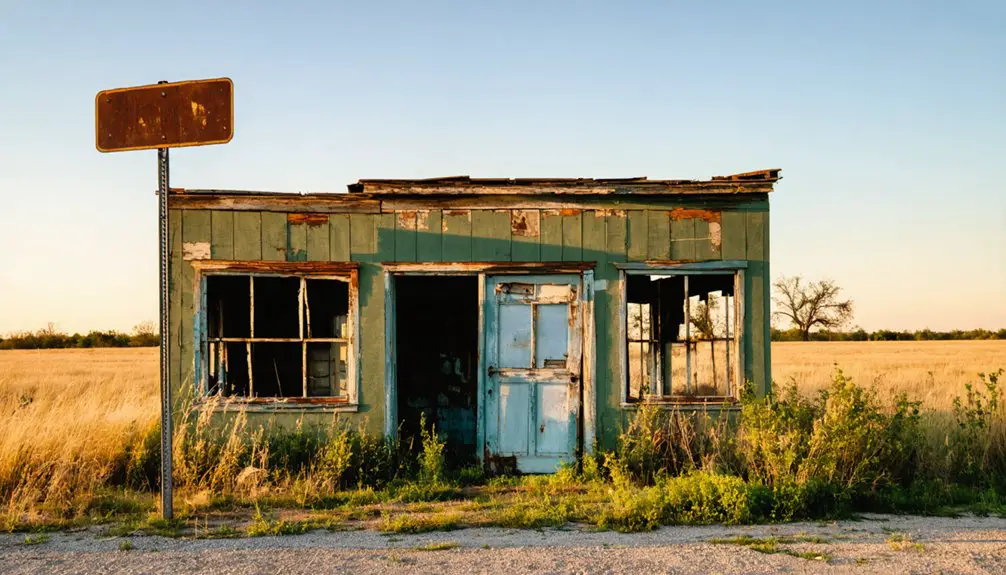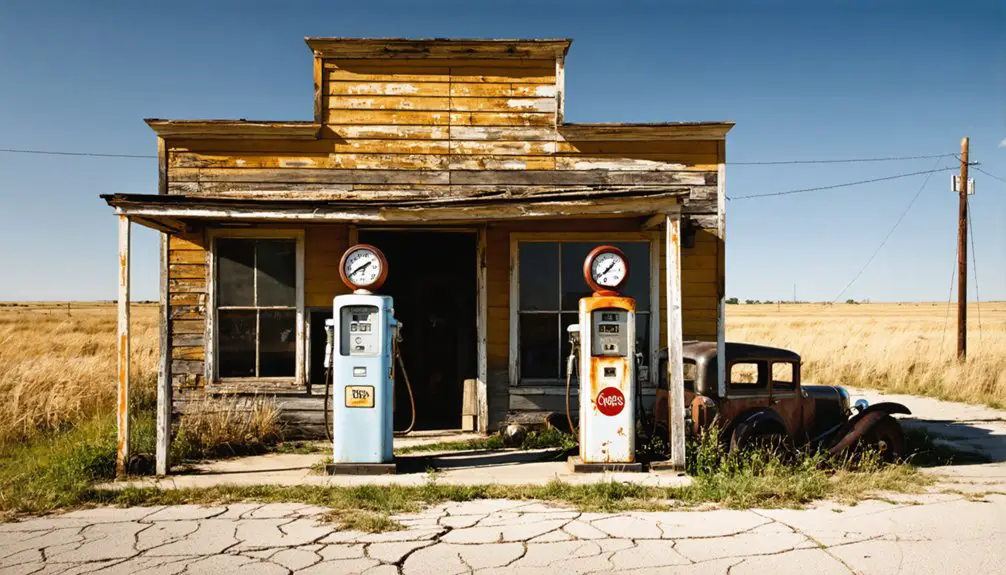You’ll find Douthat’s haunting story among Oklahoma’s most dramatic ghost towns. In the early 1900s, this booming lead and zinc mining community housed 3,000 residents, thriving with local businesses, churches, and a close-knit mining culture. But by mid-century, depleted mines and devastating environmental contamination forced everyone to abandon ship. Today, toxic chat piles and contaminated soil have transformed this once-prosperous town into a restricted wasteland – a stark reminder of boom-town destiny.
Key Takeaways
- Douthat was a thriving mining town of 3,000 residents in early 1900s Oklahoma, centered around lead and zinc production.
- The town’s economy collapsed when mining operations ceased in mid-20th century, leading to widespread abandonment.
- Over 100 million tons of toxic mining waste contaminated the area’s soil, water, and air quality.
- No structures remain today, and the area is part of the Tar Creek Superfund site requiring extensive environmental cleanup.
- Access is strictly limited to environmental workers and researchers due to severe contamination and safety hazards.
The Rise of a Mining Powerhouse
When prospectors discovered rich deposits of lead and zinc in northeastern Oklahoma during the late 1800s, they set in motion a mining boom that would transform the region.
You’d have witnessed Douthat and surrounding towns quickly emerging as powerhouse mining communities, especially after Harry Crawfish’s pivotal 1913 claim expanded the Tri-State Mining District.
The Quapaw tribal members were forced into unfair mining leases that provided them no profit from the operations.
As mining techniques advanced and railroad connections improved, ore excavation reached staggering levels.
During World War I, the area became strategically vital as it supplied 45% of U.S. lead and zinc for the war effort.
By 1926, you could find nearly 11,000 men working in about 250 mills across Ottawa County, making it the world’s largest lead and zinc producer.
The region’s economic might became clear during both World Wars when it supplied up to 75% of metals for bullet production, while generating over $1 billion in revenue between 1908 and 1950.
Life in Early 20th Century Douthat
In early 1900s Douthat, you’d find a bustling community centered around lead and zinc mining, with about 3,000 residents going about their daily lives.
You could pick up your mail at the local post office, established in 1917, or catch up on local news through the weekly newspaper, *The Independent*.
Beyond the mines that dominated the economy, the town supported various businesses that served the mining families, creating a close-knit community where miners and merchants knew each other by name. Like many towns from this era, Douthat eventually declined due to resource depletion and the shift of residents to urban areas. Similar to Tar Creek Superfund site towns nearby, environmental concerns also contributed to its abandonment.
Mining Community Daily Activities
Life in early 20th century Douthat revolved around the demanding rhythms of lead and zinc mining operations, where workers spent up to 12 hours daily in dangerous underground conditions.
You’d find men heading to the mines while their families tended home gardens and visited company stores for supplies.
When you weren’t working, community gatherings centered around local churches and schools, where you’d join neighbors for baseball games, dances, and seasonal festivals.
Daily routines included stopping at the company store, where you’d often rely on credit between paydays.
The mining company controlled most aspects of life, from your housing to where your children attended school.
Despite harsh conditions and health risks from ever-present mine dust, you’d find comfort in the strong bonds formed with fellow mining families through shared experiences.
The mining operations, which produced materials for ammunition in both World Wars, employed hundreds of workers across more than 300 mines in the region.
Town Infrastructure and Services
Early 20th century Douthat’s infrastructure reflected its mining company roots, with hastily built wooden houses lining dirt roads near the mines.
You’d find basic services struggling to keep up with the town’s growth, facing significant infrastructure challenges as the mining population expanded.
Essential services were significantly limited:
- Water came from local wells, often contaminated by mine runoff
- Electricity primarily served mining operations, not homes
- Outhouses and basic septic systems handled waste disposal
- Fire protection relied on volunteer efforts, if available at all
Despite service limitations, you’d find community life centered around general stores and company offices, while churches and schools operated from simple buildings.
The railroad served as Douthat’s lifeline, connecting residents to broader markets and enabling ore shipments that kept the town alive.
Mining Operations and Economic Impact
While many small towns emerged during Oklahoma’s early development, Douthat’s story became inextricably linked to the massive Tri-State Lead and Zinc District that transformed northeastern Oklahoma, southwestern Missouri, and southeastern Kansas into one of America’s most productive mining regions.
The town’s mining operations expanded rapidly after the railroad’s arrival, with over 300 mines eventually dotting the landscape. Environmental devastation followed as mine shaft cave-ins severely damaged the surrounding area. You’ll find that during the 1920s and ’30s, the area dominated global lead and zinc production, generating more than $1 billion in mineral wealth.
Lead and zinc mining transformed Douthat into an industrial powerhouse, with hundreds of mines generating unprecedented wealth during the 1920s-30s boom.
The economic consequences were initially promising, with thousands of jobs created, but the wealth concentrated in company hands while Native American landowners received minimal compensation.
When the mines closed, Douthat’s fate was sealed, leaving behind toxic chat piles and contaminated waterways as stark reminders of its boom-and-bust legacy.
The Turning Point: When the Mines Closed
When the mines of Douthat began shutting down in the mid-20th century, you’d have witnessed a rapid unraveling of the town’s economic fabric that had supported nearly 3,000 residents.
You’d have seen workers and their families departing en masse, seeking new opportunities as the mining operations – which had been the lifeblood of the community – ceased one by one. Like many towns that experienced economic booms and busts, Douthat’s fate was sealed by the changing economic landscape.
The exodus hit local businesses particularly hard, as the shrinking population could no longer sustain the shops, services, and social institutions that had once made Douthat a thriving mining town. The town’s decline required careful page disambiguation to distinguish it from other abandoned mining communities with similar names.
Economic Impact Ripples
The closure of lead and zinc mines in the early 1970s dealt a devastating blow to Douthat’s economic decline, marking the beginning of its transformation into a ghost town.
You’d have witnessed a rapid unraveling of the town’s economic fabric, as businesses shuttered and families were forced to seek opportunities elsewhere.
The ripple effects of this collapse touched every aspect of community life:
- Property values plummeted as environmental contamination surfaced
- Local tax revenue dried up, crippling essential municipal services
- Schools faced declining enrollment, leading to eventual closure
- Neighboring towns felt the impact as regional commerce networks crumbled
The economic decline triggered a wave of community displacement that would forever alter Douthat’s landscape.
What was once a thriving mining hub became a stark reminder of how quickly fortune can change when a town’s economic foundation crumbles.
Worker Exodus Begins
As mining profits plummeted in the early 1970s, you’d have witnessed a mass departure of workers and their families from Douthat’s once-bustling streets.
The worker migration hit hard and fast – from a peak of 11,000 miners in the region, the workforce vanished as mines shuttered their operations by 1974.
Where you once would’ve seen a vibrant community of 3,000 residents, community resilience was tested as families faced tough choices.
With toxic chat piles growing and contaminated water seeping into groundwater, health concerns accelerated the exodus.
Workers scattered across the country seeking new opportunities, leaving behind their homes, businesses, and decades of mining heritage.
The mass departure marked the beginning of Douthat’s transformation from a thriving mining town into a ghost town.
What Remains Today

Modern visitors to Douthat won’t find much of the once-bustling mining town, as complete abandonment and environmental contamination have erased nearly all traces of its existence.
Time and toxicity have swallowed Douthat whole, leaving only ghostly echoes of its mining-town past.
The remnants today consist mainly of toxic chat piles and contaminated soil, making the area unsafe for exploration or development. Like the nearby town of Picher, health and safety concerns led to a mandatory evacuation of all residents.
The environmental hazards that dominate the landscape include:
- Over 100 million tons of toxic mining waste
- Contaminated groundwater and surface water
- Heavy metal pollution in the soil
- Ongoing environmental cleanup expected to last 50 more years
You’ll find no standing structures, maintained roads, or operational infrastructure within the town’s former boundaries.
As part of the larger Tar Creek Superfund site, Douthat remains off-limits to permanent settlement, with only occasional environmental workers and researchers accessing the area under strict safety protocols.
Legacy Among Oklahoma Ghost Towns
While many Oklahoma ghost towns share similar tales of boom and bust, Douthat’s legacy stands apart due to its dramatic environmental aftermath.
Like other settlements of its era, you’ll find Douthat’s history intertwined with the state’s railroad expansion and economic transformations that shaped early communities.
When you explore Douthat’s ghost town significance, you’ll discover it mirrors the familiar pattern of Oklahoma settlements that rose and fell with changing transportation routes and economic forces.
Similar to the town of Sumner, Douthat’s development was significantly influenced by the arrival of the East-West Road that connected it to neighboring communities.
The town’s story reflects the broader cultural heritage of Oklahoma’s frontier days, when communities lived or died by railroad decisions and resource availability.
Today, Douthat serves as a symbol of the transient nature of boom-town prosperity and stands as a reminder of how quickly fortunes can change in the heartland.
Frequently Asked Questions
Are There Any Known Graveyards or Cemeteries Near Douthat?
While you’ll find unnamed rural graveyards dotting the landscape, nearby Cardin and Picher cemeteries tell the region’s mining history. You’re best exploring these sites with a local guide’s knowledge.
What Happened to the Mining Equipment After Operations Ceased?
You’ll find most mining equipment was abandoned in place – left in pits, shafts, and surface areas. With no historical preservation efforts, pumps flooded, machinery rusted, and contaminated water filled the mines.
Did Any Notable Crimes or Accidents Occur in Douthat?
You won’t find records of major Douthat crimes or accidents in historical documents. While mining towns often saw their share of incidents, Douthat’s legacy focuses more on environmental concerns and economic decline.
Are There Restrictions on Visiting or Photographing the Site Today?
Like a fortress guarding toxic secrets, you’ll need landowner permission before exploring. Visiting guidelines and photography rules are strict since the area’s part of a hazardous Superfund site.
What Indigenous Tribes Originally Inhabited the Douthat Area Before Mining Began?
You’ll find the Quapaw Nation’s tribal history most prominently in this area, with cultural significance dating to 1834, while earlier Indigenous peoples like Apache, Osage, and Wichita also called these lands home.
References
- https://en.wikipedia.org/wiki/List_of_ghost_towns_in_Oklahoma
- https://kids.kiddle.co/Douthat
- https://www.okhistory.org/publications/enc/entry?entry=GH002
- https://www.youtube.com/watch?v=FZJc5Ivk2J4
- https://www.youtube.com/watch?v=2Umqz7LrpyE
- https://en.wikipedia.org/wiki/Tar_Creek_Superfund_site
- https://www.mininghistoryassociation.org/Journal/MHJ-v1-1994-Sewell.pdf
- https://www.gsd.harvard.edu/2021/06/tar-creek-remade-taking-on-120-years-of-environmental-injustice-at-an-oklahoma-superfund-site/
- https://en.wikipedia.org/wiki/Picher
- https://www.epa.gov/mo/celebrating-10-years-tribes-cleanup-partnership-tar-creek-superfund-site



